The Bundesgrenzschutz (BGS / “Federal Border Guard”) was the first national-level armed service established in West Germany after WWII. It utilized a number of WWII items during the Cold War.

(New BGS troopers take their service oath in 1963.)
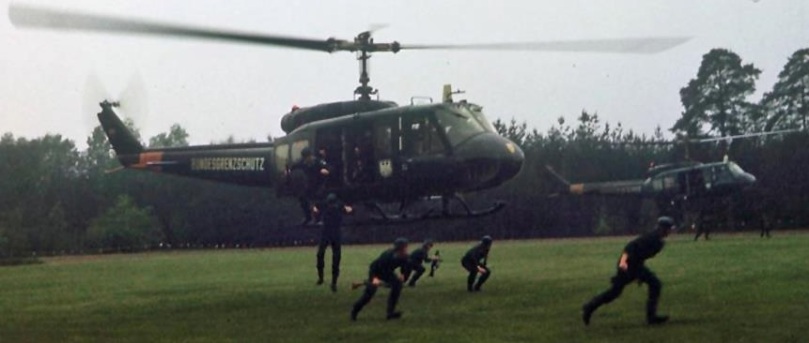
(BGS border troopers disembark from UH-1 Iroquois helicopters in 1976. The combination of stahlhelm helmets and hueys makes an interesting mixture of WWII and Vietnam War items.)
In 1945, the Allies decreed that any future German nation would be permanently disarmed. During the 1945-1949 occupation, the three western Allies (UK, France, and the USA) did not allow anything more than local police armed with light small arms. West German sovereignty was restored in 1949. In May 1950, the Allied Joint Chiefs Of Staff proposed a West German armed force of 5,000 men to patrol the new nation’s borders. In January 1951 Konrad Adenauer, the first postwar Chancellor, ordered the formation of a 10,000 man armed border guard to be placed under civil control of the Interior Ministry. On 16 March 1951 the Bundesgrenzshutz officially came into existence.
The leader of the BGS was the Inspekteurgeneral (Inspector-General). This rank was equivalent to NATO’s O-6 level, ie a one-star Brigadier General in the Canadian or US armies.
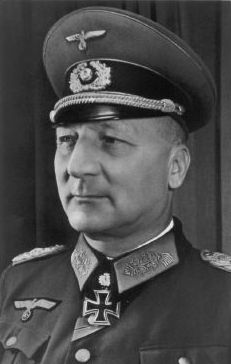
The first Inspekteurgeneral was Anton Grasser (above in WWII uniform), who had been a Lieutenant-General of the Wehrmacht during WWII, commanding first the 25th Panzergrenadier division and later the whole LXXII Korps by the end of the war. He was a recipient of the WWII Ritterkruez (Knight’s Cross of the Iron Cross); one of nine recipients later serving in the BGS. Grasser held the post from it’s creation until June 1953. He was relieved by Kurt Andersen, who had commanded the Luftwaffe’s 23rd Flak division during WWII.
The mission
The BGS’s mission was legal security of West Germany’s borders. However from the start, it was a very para-military force due to the extreme tension of the inter-German border, where the heavily armed forces of NATO and the Warsaw Pact squared off. As such, the BGS would almost certainly be the first West German units directly exposed to an attack and the BGS had to be prepared for at least a low level of traditional military combat.
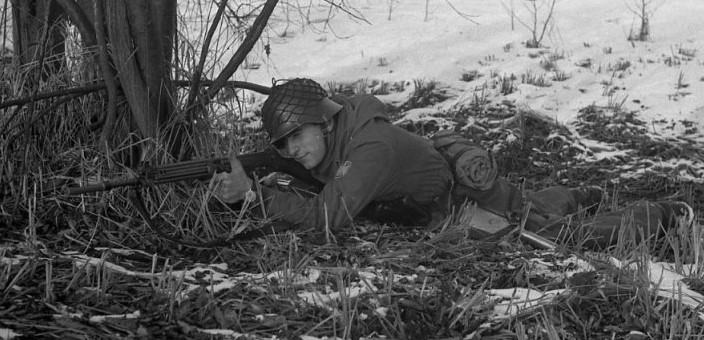
(BGS trooper after the force re-equipped with the modern G1 assault rifle, but still with stahlhelm helmet.)
The vast majority of the BGS’s first NCOs and officers were ex-Wehrmacht WWII veterans.The BGS preceded the formation of the Bundeswehr (West German military) by three years. When the Bundeswehr was formed, 43% of it’s first enlistees were transfers from the BGS.
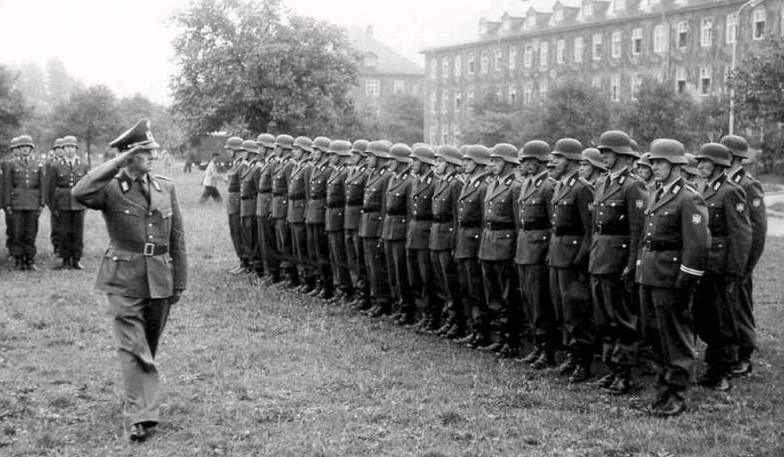
(BGS troopers in formation during the mid-1950s, wearing WWII stahlhelms.)
Whereas the East German border guards were concerned with keeping their own citizens in, a primary task of the BGS was keeping foreign infiltration out of West Germany. This was not spy novel fantasy but a very real issue. In August 1951, a number of East German infiltrators were captured. Two years later, the BGS captured a larger number of infiltrators who were sent to disrupt the 1953 West German elections.
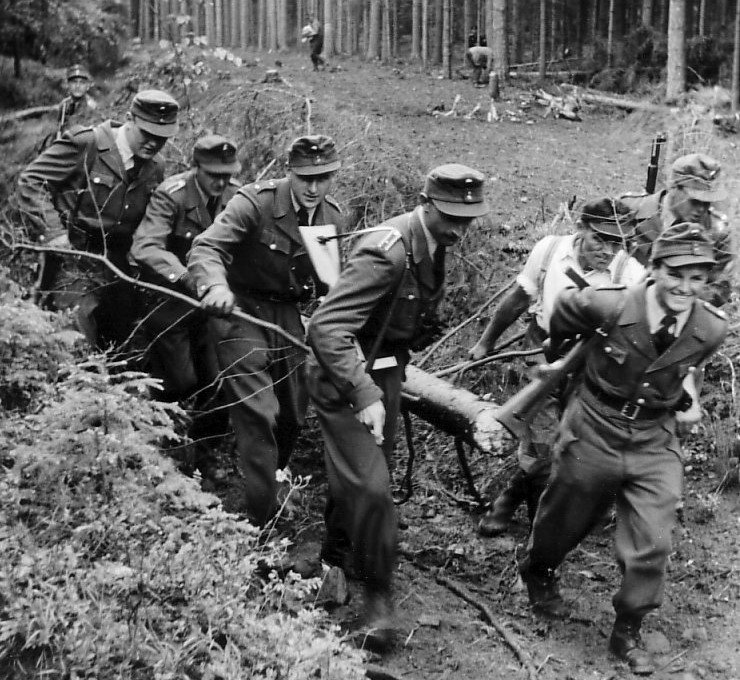
(BGS personnel clear a strip along the inter-German border in 1953; this particular area had experienced problems with infiltrators from the East. The rifle is a 98k of the WWII Wehrmacht, and the submachine gun is a MP1 based on a wartime Italian model.) (photo from http://www.beim-alten-bgs.de website)
There were other problems as well; especially during the time of the Korean War, Soviet and East German troops took potshots at West German civilians across the border. In 1953 BGS units were assigned to guard farmers during their harvest on fields along the border.
The border itself
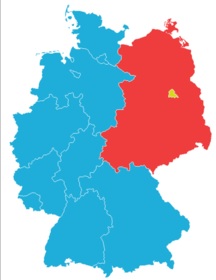
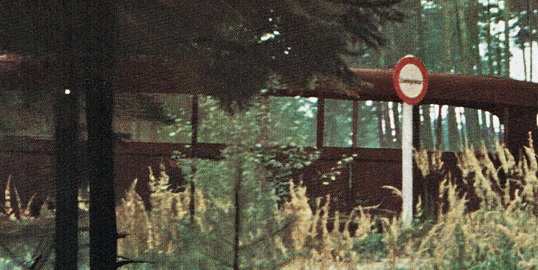
(The above photo was famous in West Germany during the Cold War. It is a Third Reich-era civilian Omnibus which had been destroyed during WWII. It happened to rest right on what became the inter-German border, and typical for the Cold War, the line was drawn right through it instead of moving the bus or adjusting the boundary.)
What became the inter-German border was decided by the four victorious Allies about eight weeks after the Third Reich’s surrender. It did not correspond to the final front lines, notably a big chunk of Germany’s Thuringia region (including Leipzig) had been occupied by the US Army during WWII but was relinquished to the USSR’s zone in the final settlement. It was not a logical line and in places bisected towns or even individual farms.
Up until West Germany regaining sovereignty in 1949, the boundary was marked with simple poles or stones (usually placed by the Soviets) and was patrolled sporadically by the occupation forces of the USSR, USA, and UK (the French zone did not meet the Soviet). During this four-year stretch after WWII, there was not even a fence and the result was 1.6 million German civilians in the Soviet zone leaving.
In 1952, East Germany sealed the border. A 33′ wide strip was plowed flat the entire length, barbed wire was strung, and some land mines were placed. The East German side was marked by red-black-yellow ‘barber poles’, placed a few inches on their side of the boundary.
This was insufficient to stop people from leaving and in 1967, the new “super-border” was built. The actual structures were moved about 75 yards inwards of the legal boundary. Here, following a “restricted area”, a colossal network of electrified fences, land mines, anti-vehicle ditches, electric lighting, watchtowers, and barriers was built; all to prevent East Germans from leaving their country. The space between the physical structures and legal boundary with West Germany essentially became a no-man’s-land. This served several purposes. During the construction it stopped workers from jumping over, later it prevented West Germans from tampering with the fence, and finally it allowed a space for the East German border patrol to shoot their own troops in East German territory if the guards themselves tried to escape.
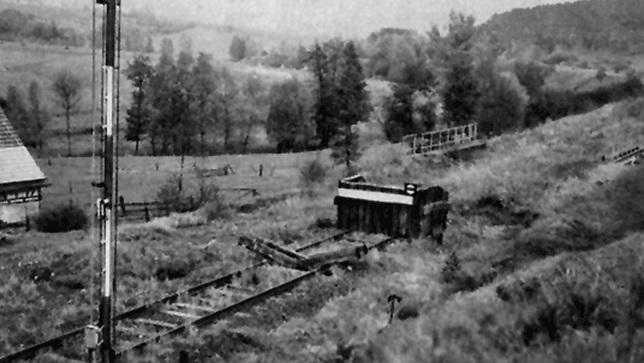
(A WWII German railroad which came to an abrupt end at the inter-German border. The tracks on the east side had been ripped up, either by the Soviets or East Germans.)
On the West German side, which the BGS patrolled, the situation could not have been more different. No effort at all was made to secure the border as, for obvious reasons, West Germans were not interested in emigrating to their East neighbor.
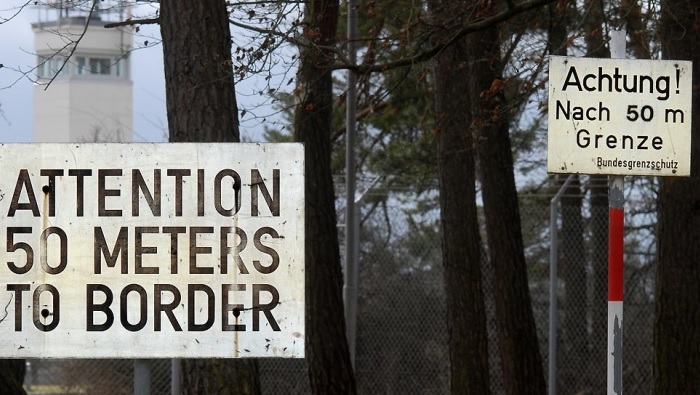
(BGS signs near Grasdorf, West Germany. Here there was a simple chain-link fence right on the actual line, with the East German “super-border” further back.)
Usually, the West German side was just marked with small signs 50 meters from the border and then another small sign right at the border, placed a few inches inside the actual boundary. Some areas had simple railings, other areas were not fenced at all.
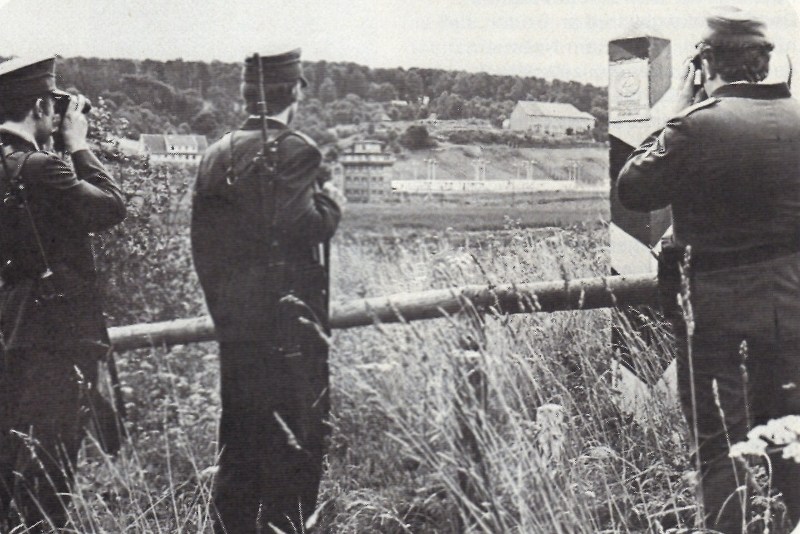
The photo above shows BGS troopers at the border. The little white plinth, probably placed by the Soviets immediately after WWII, is the actual legal boundary line. Just a few inches ahead of it is a crude log railing erected by West Germany, and a few inches just behind it is an East German ‘barber pole’. The East German fences and watchtowers lie beyond the no-man’s-land deeper inside East German territory.
When the West German Bundeswehr went on maneuvers near the border, a BGS team was always attached to ensure they did not stray to close too, or across, the border. The British Army Of The Rhine likewise sometimes included a team. The US Army did not. The US Army regularly exercised it’s postwar authority to patrol the boundary itself, all the way up to 1990.
As a democracy, West German citizens were free to walk up to the border if they so wished. There was no “restriction area”; generally the BGS left people alone until they got within about 35 yards. US Army troops were often limited to varying degrees, depending on their unit’s regulations; sometimes a mile, sometimes 50 yards, and other times a vague “mind your distance” rule. This was to prevent an international incident if a nervous East German guard fired on an American soldier from their side. American civilians were not restricted in any way.
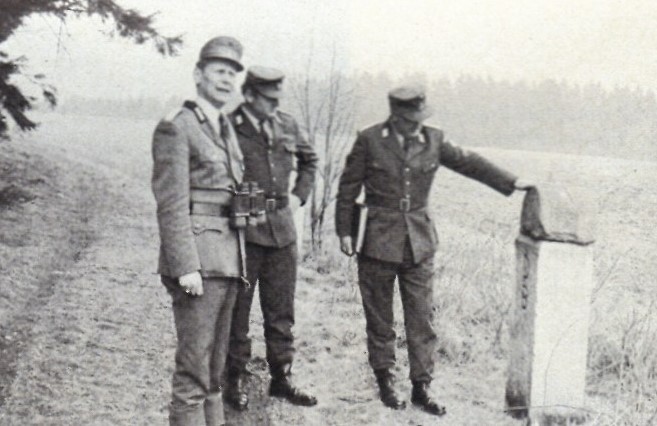
Often forgotten is that West Germany also shared a border with another Warsaw Pact member, Czechoslovakia, as seen above. While the military danger of invasion was the same, the West German / Czechoslovak border was less tense politically. This had been Germany’s border prior to the 1938 occupation of the Sudetenland, and some markers in this area dated to the Third Reich era.
WWII equipment in the BGS
ARMORED VEHICLES
The 6×6 M8 Greyhound was a highly-mobile and very effective combat scout vehicle of the US Army during WWII. It weighed 8 ½ tons, and was armed with a M6 37mm anti-tank gun, a coaxial M1919 machine gun, and a M2 Browning .50cal on an anti-aircraft ring. It had a four-man crew, and Hercules JXD gasoline engine with a top speed of 55mph.
After Germany’s 1945 surrender, the M8 Greyhound became the “go-to” choice of the US Constabulary, which enforced American authority in the USA’s occupation zone between 1946-1949. Economical to operate and maintenance-friendly, it offered an appealing option inbetween jeeps and tanks.
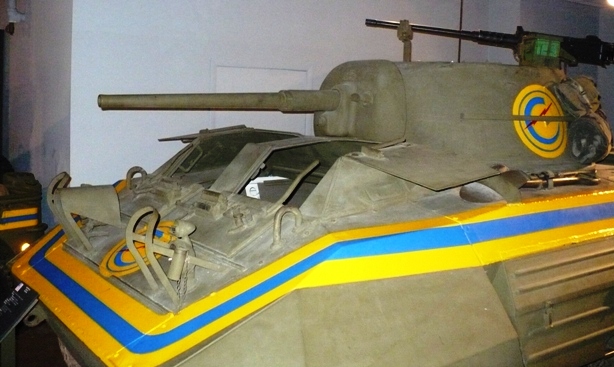
(A M8 Greyhound, still with the main gun and AA gun, in US Constabulary occupation markings.)
When the BGS was formed, the M8 Greyhound made a likewise attractive option as a heavy patrol vehicle. It would not tear up West German roads the way a half-track might, and it was still nimble enough to go cross-country along the border. By 1951 West German citizens were used to seeing the Constabulary’s six-wheeled Greyhounds rumbling around and it was a less startling sight than something new would have been.
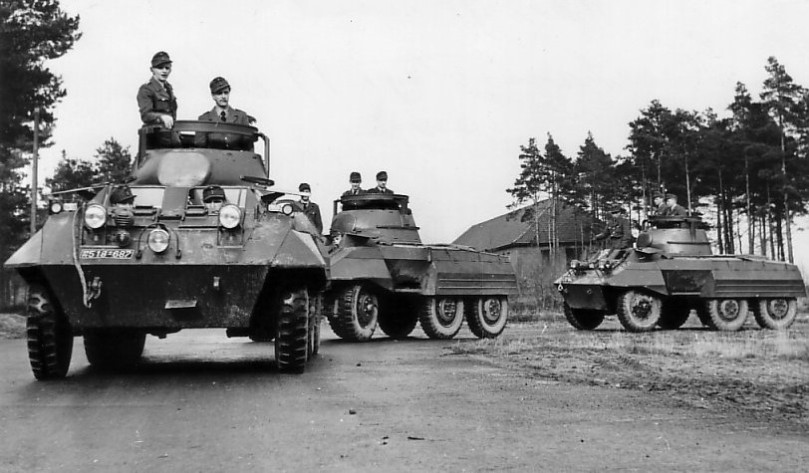
(Demilled Greyhounds of the BGS in 1952, with the mantlet plated over.) (photo from http://www.beim-alten-bgs.de website)
The M8 Greyhounds donated by the disbanding Constabulary were “demilled” prior to handover to the BGS. The 37mm gun and it’s gunsights, coaxial machine gun, AA gun, and internal ammunition racks were all stripped out, and the gun mantlet covered by a piece of sheet metal. The first BGS drivers were trained by the US Army at Dannenberg.
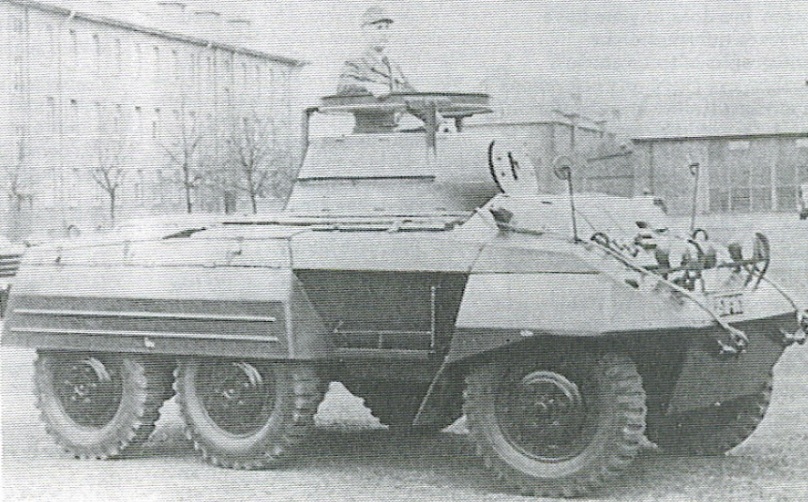
(M8 Greyhound of the BGS with the new mounting kit fitted, but no machine gun yet installed.) (photo from May 1995 issue of Armored Car Journal)
Later, the BGS devised a new turret fitting for the MG-42, which was installed. The AA gun was typically not installed, although the ring was usually left in place.
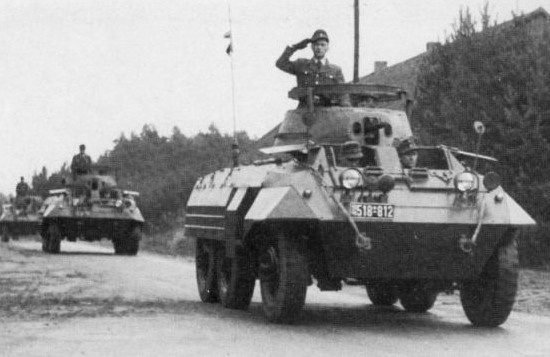
(BGS Greyhounds with the WWII MG-42 machine gun installed.)
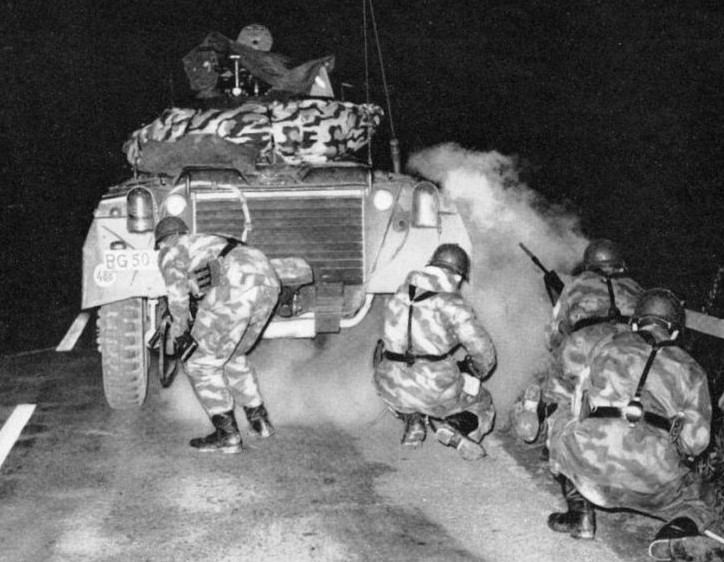
(A rearmed BGS Greyhound with additional equipment fitted and a non-standard, possibly local, camouflage turret wrap. The troopers in their stahlhelms carry the G1 so this was in the late 1950s or after.)
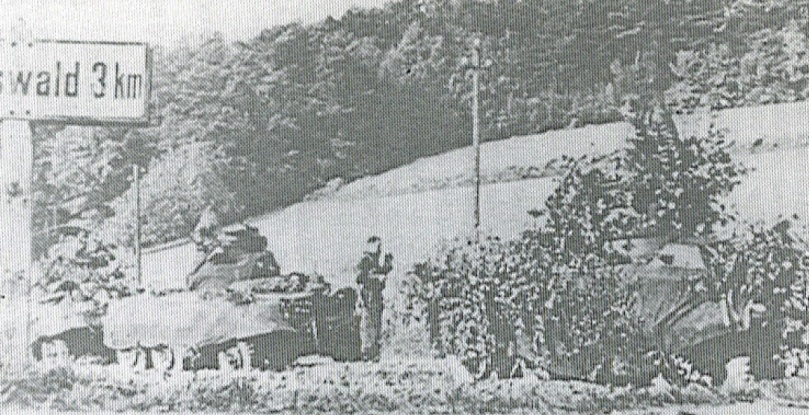
(A different style of locally-made camouflage on MG-42 equipped BGS M8 Greyhounds.) (photo from May 1995 issue of Armored Car Journal)
At the end of the 1950s, a version called the Zobel was fielded. This had the turret removed altogether and replaced by a semi-enclosed mount for a 20mm autocannon. Few of the BGS’s Greyhounds received the Zobel upgrade.
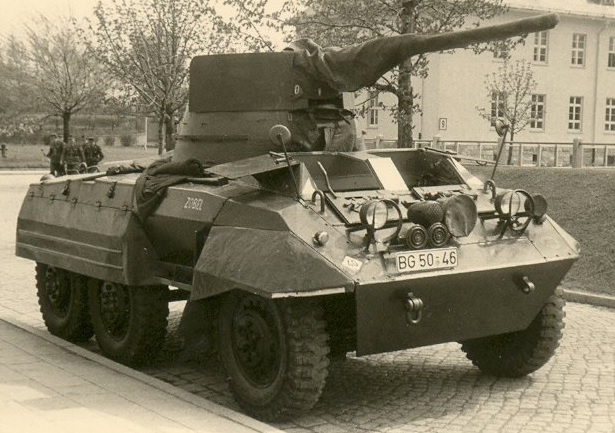
(photo from http://www.beim-alten-bgs.de website)
In 1960, the Greyhound was supplanted in BGS service by a new, purpose-designed armored personnel carrier called Sonderwagen 1 or more commonly SW-1. By the mid-1960s the WWII Greyhounds were gone, having given good service.

(1960 BGS troopers with stahlhelms and G1 assault rifles disembark from a then-new SW-1 which replaced the Greyhound that year. It is an interesting combination of 1940s helmet, 1950s firearm, and 1960s APC.)
MACHINE GUNS
For a squad automatic weapon, the WWII Wehrmacht’s MG-42 was the BGS’s instant choice. The MG-42 was one of the best, if not the best, machine guns of it’s category during WWII and is regarded as one of the best machine guns overall ever designed in any era.
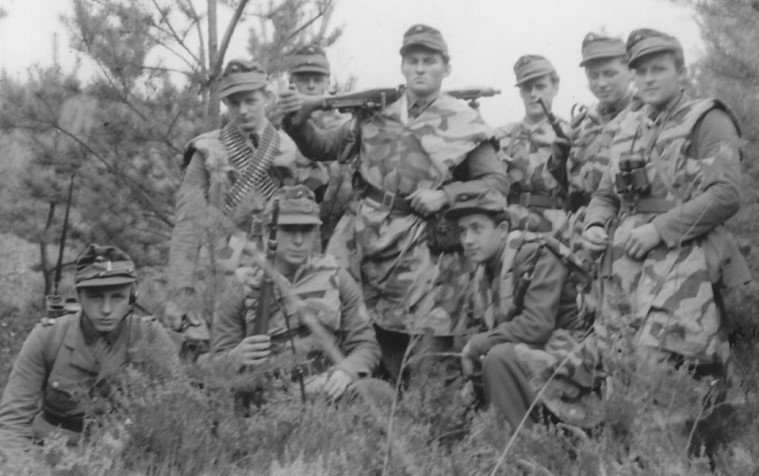
(BGS border patrol squad in the mid-1950s, with MG-42 machine gun and 98k rifles. The radio may be a SCR-300, the standard US Army set of this type during WWII. Around 1960, the BGS switched to the FuG 6, a West German system similar to the US Army’s AN/PRC-6 of the Korean and Vietnam wars.)
As built in WWII the air-cooled MG-42 weighed 25lbs 8ozs. Operating from the short recoil system, it fired the 7.92x57mm Mauser cartridge from a 250-round non-disintegrating belt, or a 50-round belt in a Gurttrommel snail drum. It was full-auto only and belt-fed only, with a 1,200rpm rate of fire. Muzzle velocity was 2,428fps and effective range was 2,187 yards although it could reach (less accurately) ¾ of a mile. It had iron sights adjustable from 200 to 2,000 meters and was fitted with a folding bipod. The charger handle was unlinked from the bolt as not to move during firing. The barrel was designed for quick changeout. The MG-42 was equipped with the Tiefenfeuerautomat, which would “move” full-auto fire in roughly a 500 yard window if the gunner was unsure of the target’s range.
The BGS used the MG-42 in several versions. The first was actual WWII-production MG-42s in the 7.92 Mauser caliber. In December 1951, France “loaned” (similar to the 98ks described below) 6,000 MG-42s which had either been captured in France during WWII or secured in the French occupation zone thereafter. These joined a much smaller number of MG-42s donated by the US Army from storage the USA’s occupation zone. France also provided the BGS ammunition and belts, along with repair parts. These WWII-built guns, still in 7.92 configuration, were used in the early 1950s. The BGS retained the Wehrmacht’s MG-42 designation. Little training was needed for BGS members who were WWII veterans, as the MG-42 saw action on all fronts during WWII.
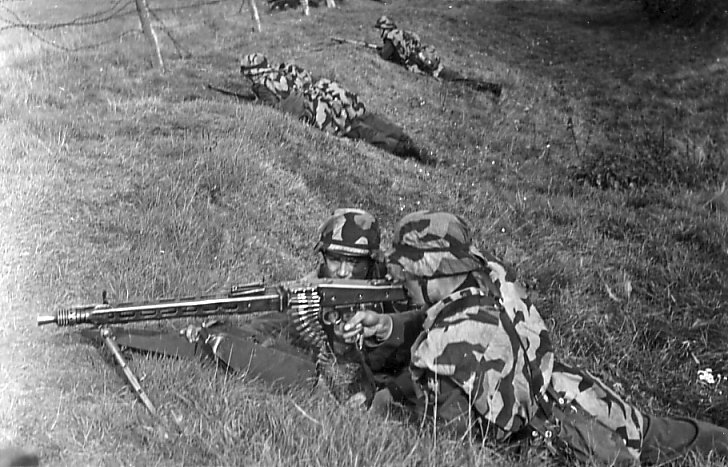
(BGS team in the “Nord” (northern) border sector in 1953, armed with MG-42 machine gun and 98k rifles, both WWII Wehrmacht weapons.) (photo from http://www.beim-alten-bgs.de website)
The designation MG1 referred to MG-42s, either converted WWII production or post-war production, rechambered to the 7.62 NATO cartridge. The conversion was not difficult, as the WWII 7.92 Mauser and Cold War 7.62 NATO rounds had similar characteristics. These began to enter BGS service in 1955-1956, gradually replacing the 7.92 Mauser version. Externally, and functionally, there is almost no difference between the MG-42 and MG1 and as the ammo changeover gathered steam, the MG1 designation was simply used for the weapon overall in the BGS. The MG1 was tremendously popular in the BGS and long-serving. The rechambering took nothing away from it’s effectiveness.
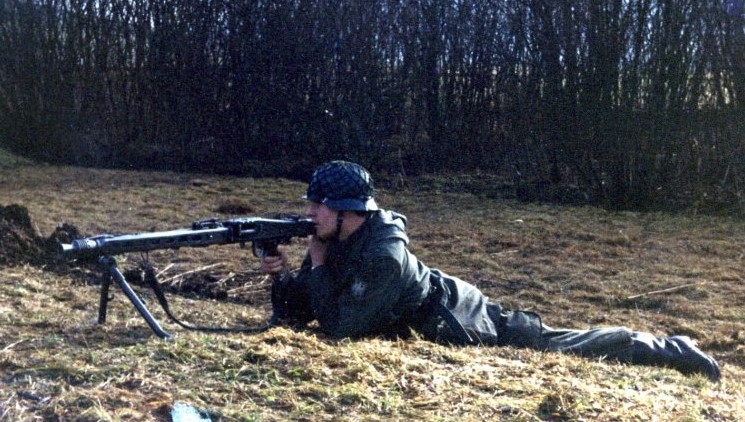
(The 7.62 NATO MG1, identical in all other respects to the MG-42.)
The designation MG2 was used for the same exact model as the MG1, but, sourced separately. Rheinmetall could not meet demand for both new-production and converted MG1s, so in 1958 West Germany made some small buys of MG-42s warehoused in allies formerly occupied by the Third Reich; these were either 7.62 NATO-rechambered there or in West Germany. The difference between MG1 and MG2 is paperwork only, they are exactly the same thing. BGS troopers usually just referred to them as MG1s.
The designation MG3 referred to a new postwar-production version, tailored for 7.62 NATO from the start. This gun (which is still in German service in 2016) generally follows the WWII MG-42 but has some internal changes and improvements. It is belt-fed from 50-round DM1 non-disintegrating belts, or 100-round DM6 disintegrating belts. It is also compatible with the US Army’s M13 disintegrating belt as used on the American M60 machine gun. Just like it’s “parent” the MG-42, the MG3 is a very successful design. Most early-1960s production of the MG3 went to the Bundeswehr; in the mid-to-late 1960s it began to join and eventually replace all the earlier versions of the family in BGS use; a process not completed until the 1980s.
RIFLES
The 98k
This was the standard Wehrmacht rifle for the entirety of WWII, and the most-produced (about 14.6 million) German firearm of the war. The bolt-action 98k weighed 9 lbs and was 3’7″ long, firing the 7.92x57mm Mauser cartridge from a stripper-loaded 5-round internal magazine. It had iron sights and was accurate out to about 550 yards, with a maximum range of 1,100 yards. Muzzle velocity was 2,493fps and the 98k had excellent stopping power.
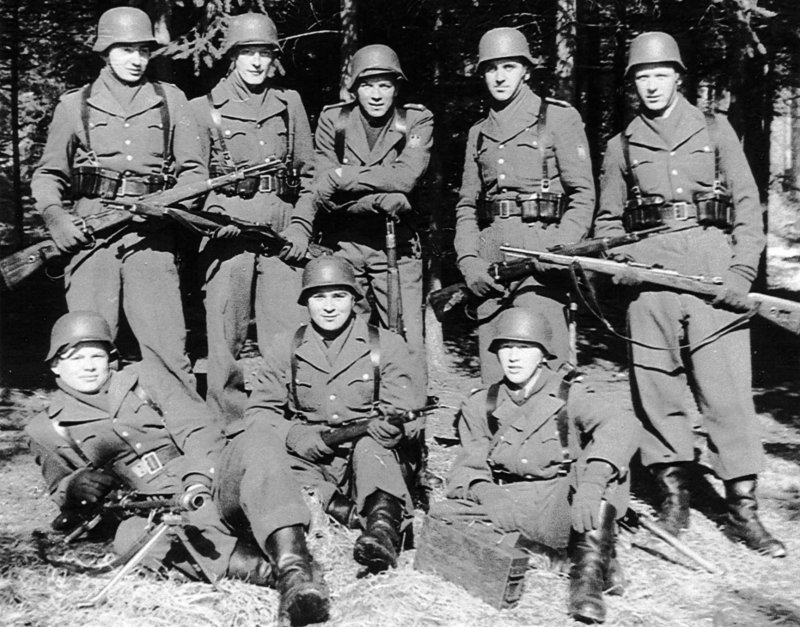
(A BGS border patrol squad in 1952, armed with 98k rifles and a MG-42. The machine gun ammo can is a Patronenkasten 41 left over from WWII, and the troopers wear stahlhelm M35 helmets from WWII.)
The BGS used two “versions” of the 98k. The first, smaller in quantity, were WWII-manufactured guns captured by the western Allies, warehoused after the war, and then reissued to the BGS when it was formed.
The other was the so-called “Frankreich (France) 98k”. After WWII, France briefly restarted production of the 98k in it’s occupation zone. These rifles differed in having no bayonet lug, and had a hexagonal steel rod under the barrel to stack themselves teepee-style in the field. The template was the “late war” version of the 98k which was of a bit cruder construction; for example the sling attachment on the buttstock was a simple rod held on by two screws. Otherwise the postwar French 98ks were identical to WWII models. After a brief production run, the French had second thoughts about their 98k project and curtailed it. Of those issued to French army units, most went to CEFEO (French forces in Indochina), or to reserve storage in France.

(A 98k of the “Frankreich” style manufactured in the French occupation zone immediately after WWII.) (Gun Digest Books photo)
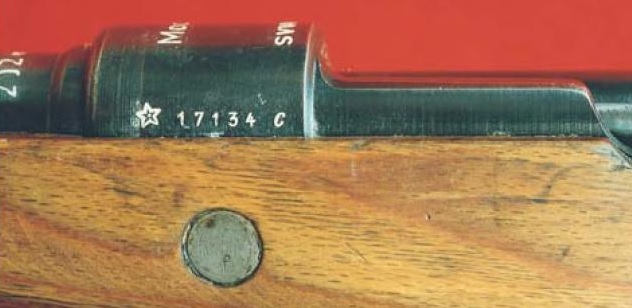
(The star marking is a French device to signify non-standard foreign equipment approved for issue to the French army.) (Gun Digest Books photo)
The BGS was issued 18,000 98k rifles in November-December 1951, almost all from France, many of the Frankreich version. These joined a smaller number of ex-Wehrmacht guns transferred from US Army warehouses. The French allotment was technically “borrowed” to skirt French arms export red tape, but with an unspoken understanding they would never ask for them back. The American allotment was a free gift.
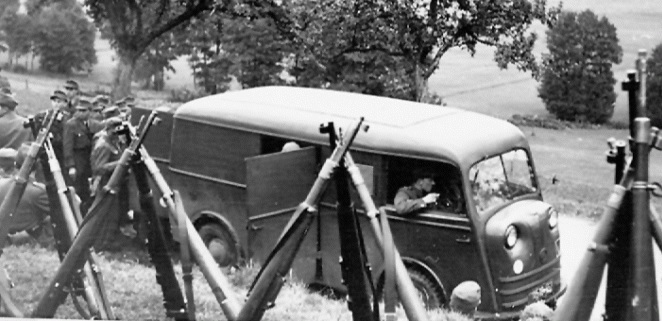
(BGS 98k rifles of the “Frankreich” version stood teepee-style. The vehicle is a Tempo Matador, a postwar 1-ton truck used by the BGS. During WWII, Tempo’s best-known vehicle was the Wehrmacht’s G 1200 staff car. The brand name Tempo was used in the immediate postwar years for a number of vehicles, including license-built Land Rovers (also used by the BGS) and the Matador, which was physically assembled by Vidal & Sohn in Hamburg.)
The French also supplied a huge allotment of 7.92x57mm Mauser rounds, from wartime captures on French soil and later seizures in the French occupation zone. This probably would have been enough but as it began to be depleted, just to be sure an order was placed with Santa Barbara in Toledo, Spain for additional ammunition.
In service, the 98k was perfect from a training perspective as any WWII veterans needed no instruction at all, while younger recruits found it easy to master. From a military perspective it was inferior to the SKS Soviet troops in East Germany were using by 1949, but as the BGS was at most a para-military organization this was acceptable.
The Enfield
A small number of BGS units used the Enfield No.4 MkI* rifle early in the force’s history. These were sold by the UK at a great discount. The * in the designation refers to a “wartime expediency” modification of the original design, with some simplified production features.

The bolt-action No.4 was, along with the SMLE and other Enfield variants, the UK’s main battle rifle of WWII. It was 2’8″ long and weighed a hefty 9lbs 2ozs. It fired the .303 British cartridge from a detachable 10-round box magazine, with a 2,464fps muzzle velocity. Like many WWII rifles of it’s type, it was a bit over-powered for it’s intended task. It had iron sights and was accurate out to about a ½ mile with a well-trained shooter.
When the Luftwaffe re-formed in 1955, it’s first ground security rifle was the Enfield No.4 MkI*, about 18,000 being issued of which some were ex-BGS. Luftwaffe veterans of the era called it the “Kanadagewehr” (Canada rifle) as all 18,000 had been manufactured by Long Branch Arsenal in Canada during WWII. Most likely all of the BGS stock was of this source as well.
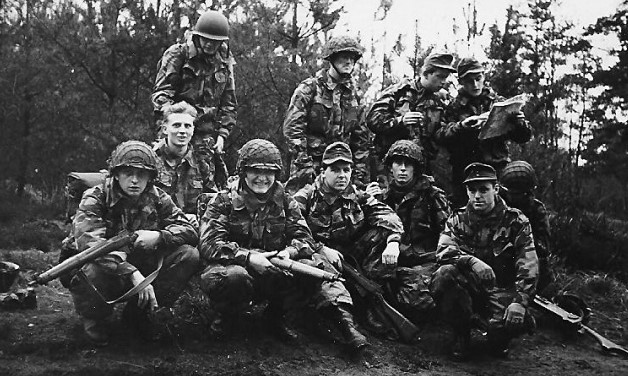
The Enfield No.4 MkI* was not popular in the BGS. It was considered too heavy, and the .303 British round was not standard with any other BGS firearm. There was no intention of retaining it long-term and no BGS designation was assigned. The No.4 MkI* was out of BGS use by the late 1950s.
Retirement of WWII rifles from the BGS
At the end of 1955, the 98ks were already a decade or more old, and increasingly obsolete compared to the SKS and AK-47s used by the Warsaw Pact forces across the border. The BGS signed a contract for Belgian-made FN FAL assault rifles, which were designated G1 by the BGS. Notably, the switch from WWII-era rifles in West Germany was led by the BGS, not Bundeswehr, which continued to use M1 Garands for the time being.
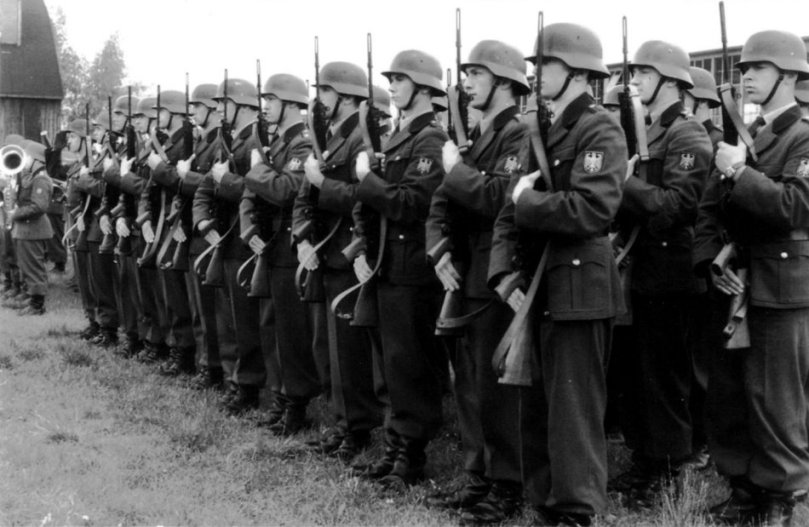
(BGS troopers shortly after the changeover from the WWII 98k to the Cold War-era G1.)
The G1 replaced the 98k in BGS service between 1956-1958. This Cold War-era weapon served alongside WWII-era guns like the MP1 which remained in use; as did WWII equipment like the stahlhelm. As soon as the G1 was fully phased in, it was joined by the Heckler & Koch G3 assault rifle, which the Bundeswehr adopted in 1959. The BGS also adopted the G3 at that time to achieve commonality with the Bundeswehr. By the 1960s, the WWII rifles were gone from the BGS, except for a few 98ks retained for ceremonial use.
SUBMACHINE GUNS
In May 1951, the USA proposed a complex deal where British WWII-veteran Sten submachine guns warehoused in the former UK occupation zone would be exchanged for an offset of international debt, with the Stens themselves being immediately written off as foreign aid and given to the new BGS. A few Stens were delivered for trials and rejected by the BGS, despite the fact that they would have been free.
A search for a West German-funded submachine gun then began. The WWII Wehrmacht’s MP-40 would have seemingly been the favorite, both from functional and training standpoints. However the MP-40 had been out of production for half a decade by then, and much of the tooling had been scrapped. More importantly, the BGS could not wait for production to ramp up, and an immediate producer was needed.
The MP1 (Beretta Modello 1938)
In October 1951 the BGS signed a contract with Beretta of Italy for 6,000 MAB-38 submachine guns. Some were delivered immediately, the rest throughout November of that year.

(MP1 submachine gun of the BGS)
Beretta’s Modello 1938, designated MAB-38 by Italy during WWII, was probably the best Italian firearm of WWII – which, granted, isn’t saying a lot. It was used by Italy throughout the conflict and was regarded as very reliable, easy to use, and effective in combat.
This weapon was not exactly new to BGS members who were WWII veterans. To replace the massive losses of MP-40s on the Russian front, the basic MAB-38 version (with it’s characteristic perforated barrel jacket) had been used under the Wehrmacht designation MP-738(i) while the simplified, “late-war” version MAB-38/44 entered Wehrmacht service as MP-739(i). In both cases, German soldiers appreciated the design as much as the Italians.
The exact version used by the BGS was Beretta’s Modello M1938/49 (also called “Model 4” in international sales literature). Produced after WWII, this was nearly identical to the “late-war” MAB-38/44. The only difference was a push-button safety in the wood forestock. The weapon was designated MP1 by the BGS.
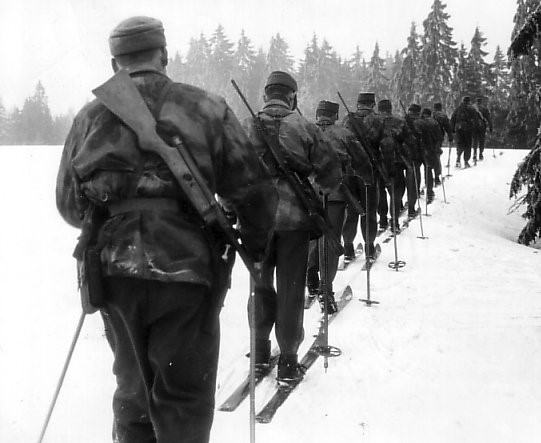
(MP1 on a BGS ski patrol in 1958. The rest of the squad has G1 assault rifles.)
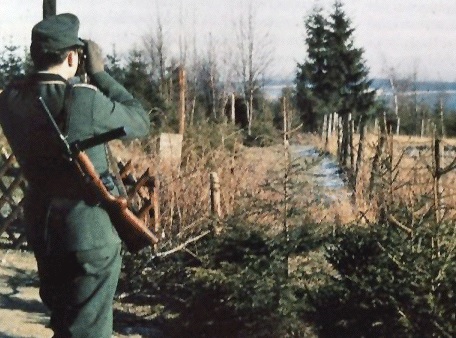
(BGS trooper with MP1 at the inter-German border in 1957.)
The MP1 weighed 7lbs 2 ozs and was 2’8″ long. Typical for Beretta products, it was built to high quality and had a chromed barrel. The forward trigger fired a single shot while the rear trigger was full-auto. A blowback design, it fired the worldwide common 9mm Parabellum cartridge from a 40-round box magazine with a muzzle velocity of 1,407fps, and had a 550rpm rate of fire. The gun had iron sights but due to it’s good design, was accurate out to about 225 yards in single shots and even out to 100 yards in fully automatic fire.
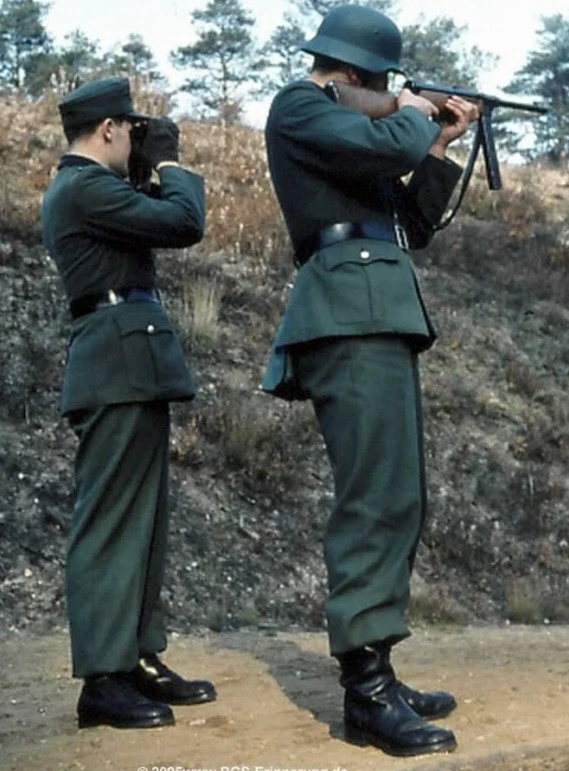
(BGS range qualifications on the MP1.)
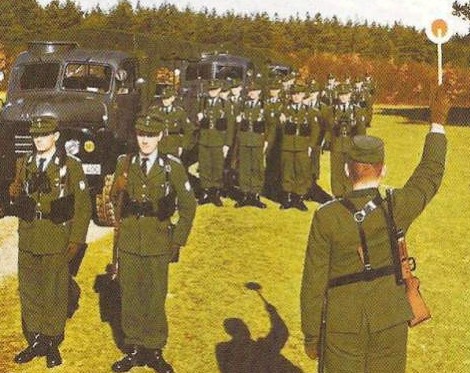
(BGS traffic controlman with a MP1.)
The MP1 was successful in it’s niche as the BGS’s first submachine gun. In November 1955, a portion of the BGS’s MP1s were transferred to the newly-formed Bundeswehr; the rest remained in use. The MP1 served in a frontline capacity from 1951 to 1965, and some remained in storage until 1969.
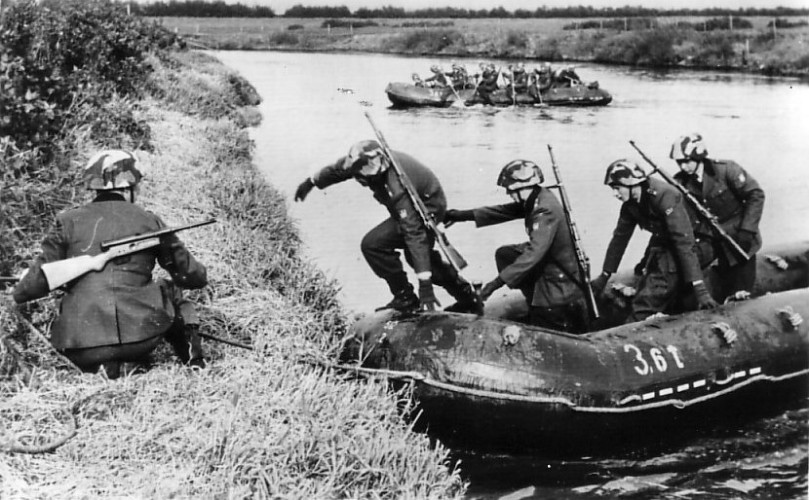
(A BGS exercise in northern West Germany during October 1955. The trooper on the riverbank has a MP1, while his comrades in the raft have 98k rifles.) (photo from http://www.beim-alten-bgs.de website)
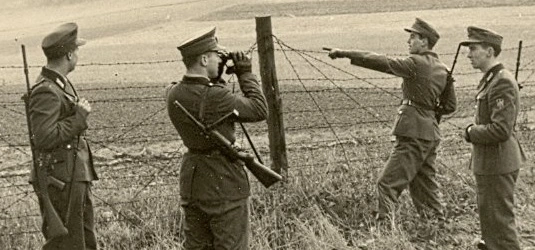
(A BGS trooper with a MP1 in the 1960s.)
The Dux
This submachine gun is more interesting for it’s backstory than design. In 1937, a German named Willi Daugs emigrated to Finland. During that country’s 1939-1940 war against the USSR, he brokered illegal importation of German weapons for the Finns, and later during WWII helped fund the Konepistooli m/44, Finland’s near-copy of the WWII Soviet PPS-43. In 1944 Daugs fled to Sweden, where he registered as a “stateless person”. Swedish authorities soon began an investigation into his earlier arms brokering deals, and Daugs fled again to Spain, taking with him blueprints and design notes from the m/44. Finding employment with Orviedo Arsenal, he began work on a submachine gun called the Dux, a Spanish version of the m/44; basically a clone of a half-clone. The name Dux means “ruler” in Latin.
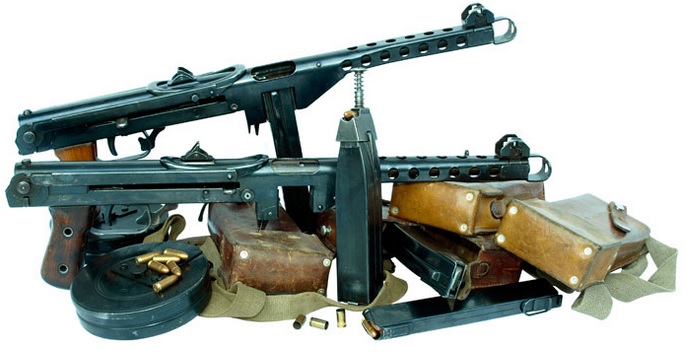
Daugs himself was not an engineer. However in 1949, he met a former WWII German gun designer named Ludwig Vorgrimmler. After WWII Vorgrimmler had briefly designed guns for the French before himself moving to Spain. Using the m/44 data provided by Daugs, Vorgrimmler completed work on the Dux in 1951. In December 1952, a few Dux prototypes were loaned to the BGS in West Germany, where they generated enough interest for a small order as the Dux 53. The decision was helped by Willi Daugs, who popped up in Munich in late 1952 and successfully registered the Dux design with the West German patent office. Shortly thereafter, Daugs moved to the tiny nation of Liechtenstein, a neutral country, to continue marketing the Dux free of arms laws in West Germany. The location in Liechtenstein was basically a mailing address only, and Daugs subcontracted actual laboratory work around Europe including West Germany.
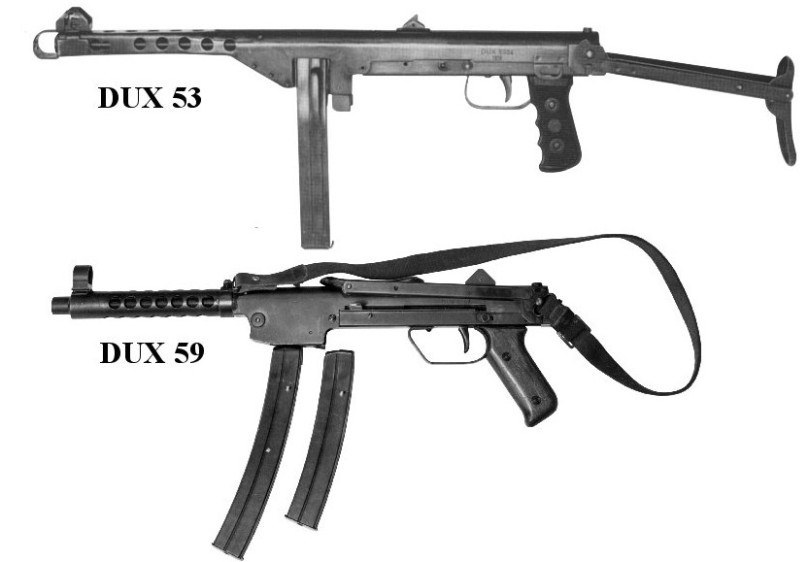
The Dux 53 was very similar to the WWII Konepistooli m/44 or PPS-43. It was a very simple and cheap full-auto, blowback-action weapon. Made largely out of stamped metal, it weighed 7lbs 12ozs empty and measured 2′ with the folding stock closed, and 2’10” with it extended. The Dux 53 fired the worldwide common 9mm Parabellum cartridge, with a 500rpm rate of fire. Muzzle velocity was 1,280fps. The magazine was a 50-round stick, of which either Finnish, West German, or Spanish models were compatible. It was also compatible with a 50-round drum copied from a WWII Swiss design. The front sight was fixed, the rear sight was a flip-up L style marked for 100 and 200 meters. The effective range was only about 100 yards.
The Dux 53 was in BGS service from 1952 to 1960. Only a few hundred were purchased. The whole eight years was, at least on paper, an “evaluation-only” period and no West German model number was assigned. One issue noted was that with a round chambered and the bolt closed, the Dux could inadvertently discharge if jarred from behind.
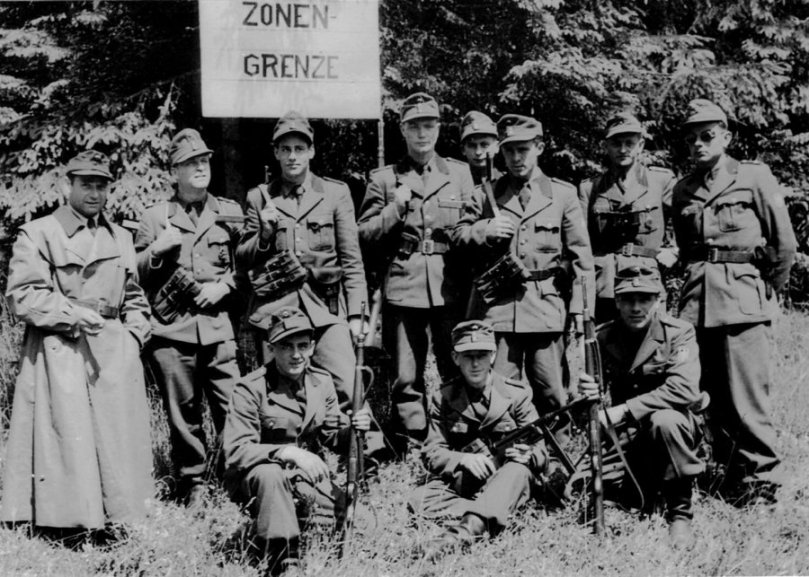
(A BGS squad along the Zonen-Grenze (border zone) in 1954. It is hard to see, but the NCO in the greatcoat on the left has a DUX 53 tucked under his arm. The rest of the squad has WWII 98k rifles. The trooper on the far right is wearing WWII schutzbrille goggles.)
While the Dux 53 was in BGS service, work continued on a more refined model. The Dux 59 was lighter (6lbs 9ozs) and measured 1’11” with the stock folded. The charger was moved from the right side to the left, with the safety switch relocated from the trigger guard to just below the charger. Ammunition remained the 9mm Parabellum, but the rate of fire was increased to 550rpm. The magazine was a 40-round banana manufactured by Orviedo in Spain; no other type was compatible.
The Bundeswehr bought twenty-five Dux 59s, manufactured under license by Anschutz in West Germany. These were entered into a 1960 competition for a new Bundeswehr submachine gun, but it was not successful.
The BGS phased the Dux 53 out around 1961 without ever having formally adopted it. By the 1960s, the Dux 53 (essentially a WWII design) was considered too obsolete to spend further West German taxpayer money on. And, after losing the Bundeswehr competition, the BGS was not going to buy the Dux 59 on it’s own. There was also a legal concern about the patent propriety of the Dux; as it was basically a West German version of a Spanish copy of a Finnish copy of a WWII Soviet original.
Withdrawal
In 1965, all of the BGS’s WWII-design submachine guns were withdrawn and replaced by the Heckler & Koch MP5.
MORTARS
The Esperanza
This 81mm mortar was a Spanish half-copy of the Wehrmacht’s Granatwerfer 34 weapon, one of the better medium mortars of WWII. It was manufactured by ECIA in Spain and imported for the BGS in the early 1950s. The 7lbs shell had a range of 2,624 yards, and both HE and illumination shells were issued to the BGS.
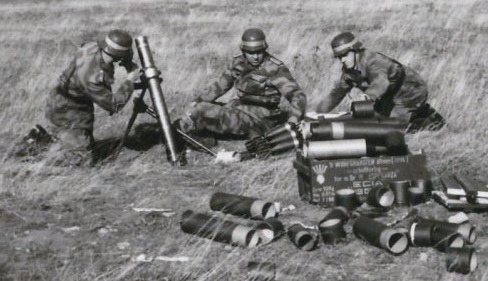
(Esperanza mortar complete with ECIA ammunition crate. The red/yellow helmet bands were used by the BGS when exercising with live ammo.)
HANDGUNS
A variety of handguns served the BGS during the Cold War. From the start, this was a mix of postwar designs like the SIG P2, and WWII designs described below.
The P-38 / P1
Walther’s P-38 was a standard sidearm of the Wehrmacht during WWII. This highly-popular semi-automatic pistol fired the common 9mm Parabellum cartridge from a 8-round detachable box magazine. Muzzle velocity was 1,200fps and the user manual’s stated effective rage was 55 yards; with longer ranges at less accuracy possible. Like the MG-42 and 98k, the P-38 was already a proven design, familiar to BGS members who were WWII veterans.
When the BGS was formed, the P-38 was one of the service’s first sidearms. These P-38s were “returns” of WWII manufactured guns captured by the American, British, and French armies. Most of them were from the French zone, as the US Army had destroyed most of the P-38s in the USA’s zone. The quantity was insufficient so new production was needed.
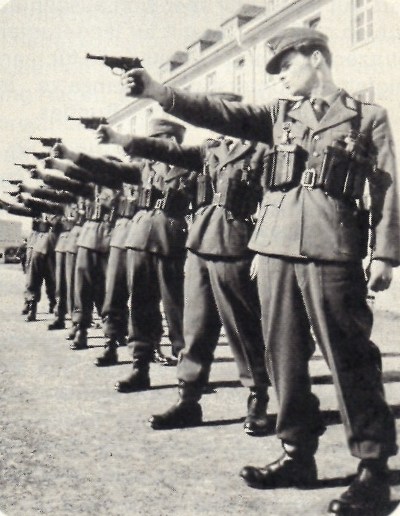
(BGS troopers with P-38/P1 pistols.)
Walther’s WWII main offices were located in what was now East Germany, and in any case the weapon had not been produced in several years. The French company Manurhin (which had made German weapons during the war) meanwhile had both blueprints and some production jig parts left over from WWII. A contract was signed in 1956 for immediate production of the P-38. The irony was not lost on either the West Germans or French.
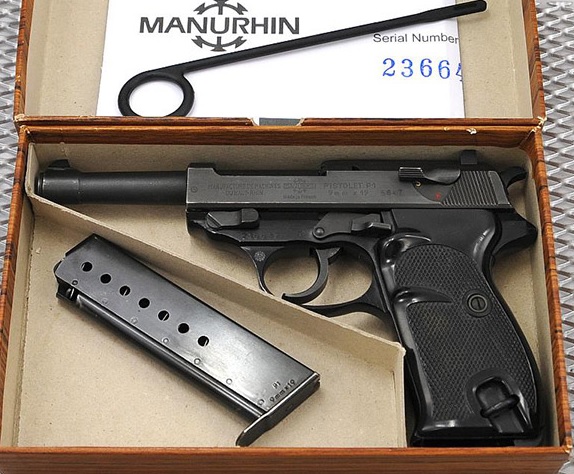
The Manurhin-made guns (and later, other manufacturers) were designated P1 by the BGS. These were nearly identical to WWII-built P-38s, and some items such as the magazine were interchangeable. The easiest identification is a four digit-number near the serial number; this is found only on postwar P1s and indicates the month of manufacture (example 1156 for November 1956). Because there was no difference between WWII and postwar production, the designation P1 was eventually applied to all of these handguns regardless of when they were built.
The P1 remained the BGS’s main sidearm until 1975, when the P4 entered service, followed by the P6 the following year. There were still a few P1s in BGS service when the two Germanys reunited in 1990. The P1 was also used by the Bundeswehr, and by civilian police departments.
The P3 (Astra 600/43)
This Spanish-made handgun had seen Wehrmacht service during WWII. It was a development of the Astra 400, an earlier Spanish pistol of 9mm Largo caliber.With WWII in full swing, gun makers in the Third Reich were already at maximum capacity and Spain (neutral but friendly to Germany) was a good source for additional small arms. The Wehrmacht requested an adaptation of the Astra 400 in 9mm Parabellum caliber, and the Astra 600 was born.
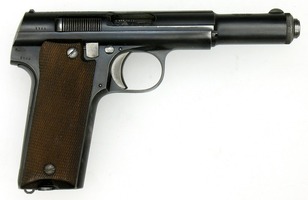
The Astra 600/43 was a blowback-operated semiautomatic handgun firing the common 9mm Parabellum round from a 8-round detachable box magazine. It was a fairly stout pistol; 8 ½” long and weighing over 2 lbs. It’s “cigar” shape was the result of the recoil spring being sited around the barrel. The only safety was a grip interlock. This gun was very reliable and fairly accurate, the only real downside being a noticeable palmslap with each shot due to the blowback operating method. In deference to Germany’s friendship with Spain, no foreign equipment designation was used during WWII; it was simply called the Astra 600/43.
The Wehrmacht placed an order for 60,000 Astra 600/43s in 1943. It was a popular weapon with German troops, and in particular Luftwaffe pilots liked it as a shootdown-survival weapon. Only 10,450 of the 60,000 had been delivered by the time the 1944 Allied advance sealed the Spanish-French border; the only route by which Germany could take delivery.
The Spanish had insisted in a staggered prepayment agreement and this left the remainder of the order in limbo after WWII. Of those on which no payment installment had been made, 800 were sold to the Portuguese navy, 450 to the Chilean army, and 200 each to the Turkish and Jordanian armies. Another 600 were bought by Spain itself but never issued.
When the BGS was formed, the forgotten-about WWII contract was a fantastic opportunity to get additional sidearms very quickly. West Germany finished payments of the nazi-era contract and also bought the 600 warehoused Spanish guns. The gun was now designated P3. Altogether 31,350 P3s were delivered to the BGS.
In BGS service, the P3 was not as well-liked as the WWII P1 or Cold War-era P2, all three of which served together simultaneously. None the less it was appreciated for being reliable and for sharing ammunition with the other two types. P3 pistols remained in BGS use until the early 1970s.
The M1911
The legendary M1911 served only in very tiny numbers and for a very short while with the BGS. During WWII, the Wehrmacht had used captured M1911s under the designation P-660(a) but it was never a common German weapon. Offered at low cost to the BGS and given a brief trial service run, no orders were placed as the .45ACP cartridge was not standard to anything else in the BGS inventory.
PERSONAL GEAR
The stahlhelm
This is most certainly the item most people today find surprising to have been retained by the BGS. The stahlhelm (literally, “steel helmet”) M35 is the helmet most associated with the Third Reich. Millions were built and it was the Wehrmacht’s battle helmet for all of WWII from start to finish. The later versions, M40 and M42, were simply the M35 with some featured deleted or simplified to speed up production as Germany’s situation worsened. The M35, with it’s distinctive coal scuttle shape, was made of pressed and stamped molybdenum alloy steel with a leather suspension and chinstrap.
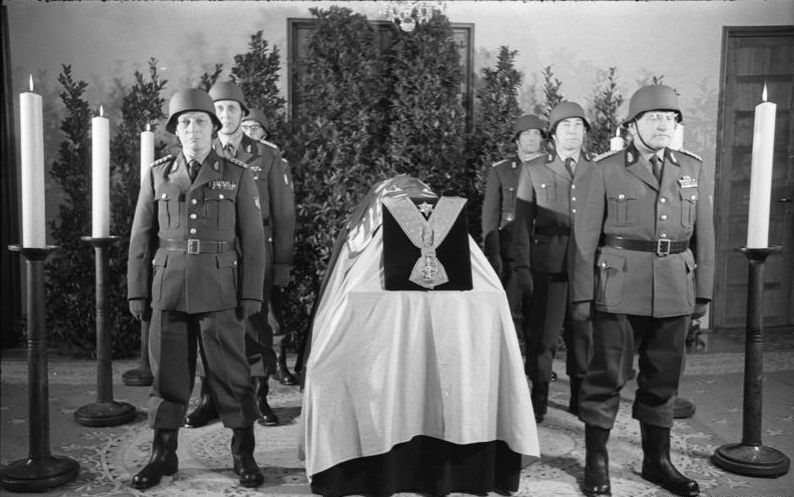
(BGS honor guard at the funeral of former Chancellor Konrad Adenauer in April 1967) (Bundesarchiv photo)
When the BGS was formed in 1951, the stahlhelm was selected as it’s helmet without any political influences. This was in contrast to the Bundeswehr, which made a conscious political decision not to adopt any Wehrmacht uniform items when it reformed in 1955. The Bundeswehr never used the stahlhelm, going immediately to the American M1 pot helmet. For the BGS, the stahlhelm was simply a proven design, immediately available, and familiar to it’s first generation of troopers.
The BGS used two models of the stahlhelm. The initial lot in 1951 was all WWII-production M35s which had been warehoused by the western Allies after Germany’s 1945 surrender. These were stripped of all Wehrmacht or Waffen-SS markings, repainted, and reissued.
By the mid-1950s these helmets were no longer sufficient in either quantity or quality. Many had been dinged up during WWII or in BGS service, and they were wearing out. It was decided to restart production in West Germany. There were two models of postwar stahlhelm M35s for the BGS.
The first was of very limited 1951 production and was exactly identical to a WWII M35. It was designated stahlhelm M35/50. These are impossible to differentiate without looking at the serial numbers. Few of these actually made it to the BGS, most went instead to local police departments.
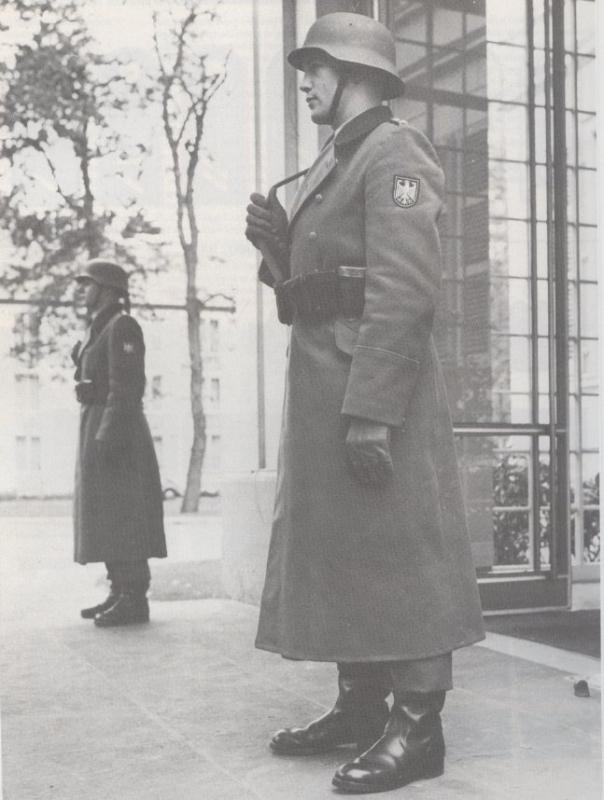
(BGS troopers stand sentry outside the new Chancellory in Bonn, which was West Germany’s capital between 1949-1990.)
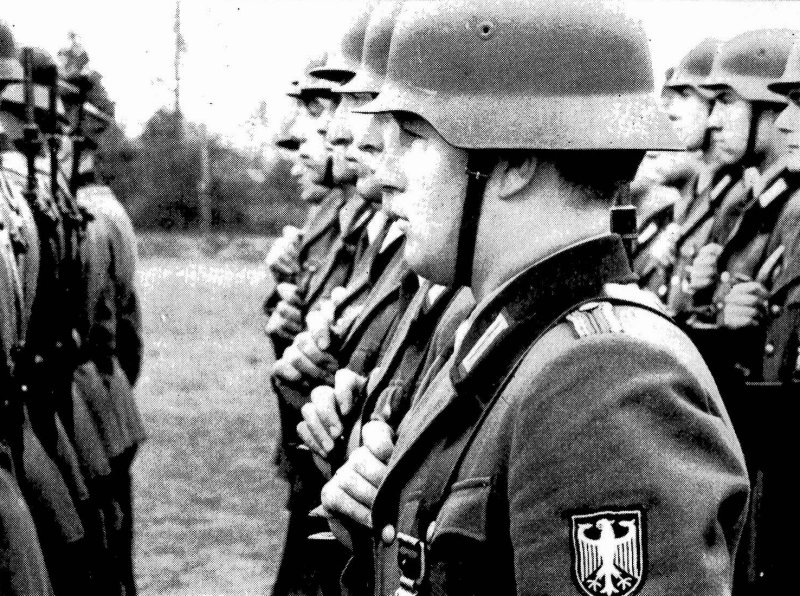
(BGS members in 1961. The model of stahlhelm appears to be the M35/50.)
The second was designated M35/53. Most collectors today consider it the final true member of the stahlhelm family. Compared to the WWII production M35, the M35/53 is “cleaner-looking” as it omits the ventilation holes and rivets. These helmets were made by a number of West German companies including Linnemann-Schneztler and FW Quist. The suspensions were made by a variety of companies. There were two sub-models to the M35/53’s suspension; one was a simplified design and the later version was a sort of hybrid between WWII German designs and that use on the USA’s M1 pot helmet.
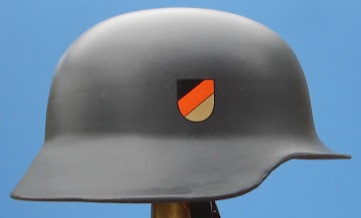
(Mint-condition stahlhelm M35/53. The BGS normally used no markings on their helmets; this was likely a parade/honor guard version.)
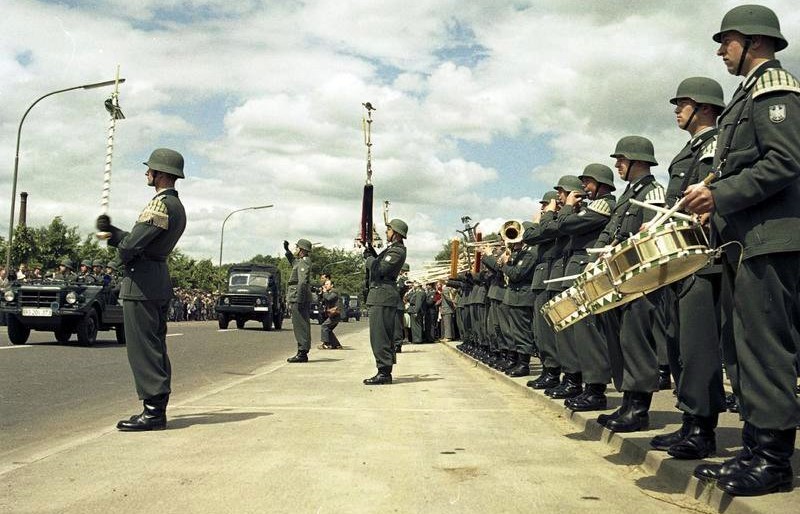
(The BGS band in 1961. The soldier in the center is holding the BGS’s Schellenbaum, a decorative object carried over from the Wehrmacht era into both the BGS and Bundeswehr.)
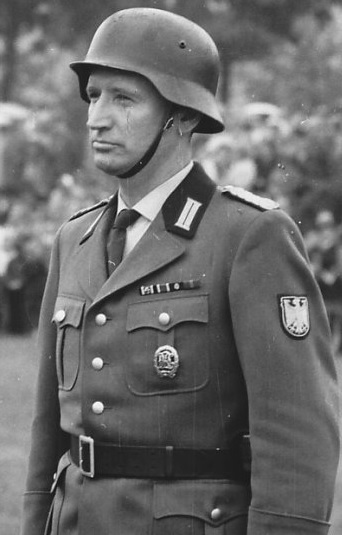
(BGS members did not wear the hanging versions of WWII medals, but wore authorized ribbon versions. The leftmost one on this NCO’s ribbon bar is the WWII Iron Cross. The breast badge deontes he is a commander of a BGS unit.)
The BGS designed their own camouflage net for the M35/53 called the tarnnetz. It was held in place by a series of clips.
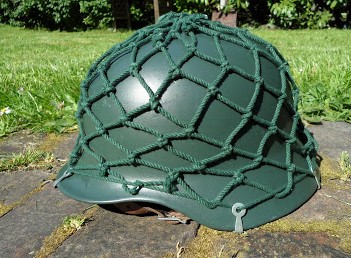
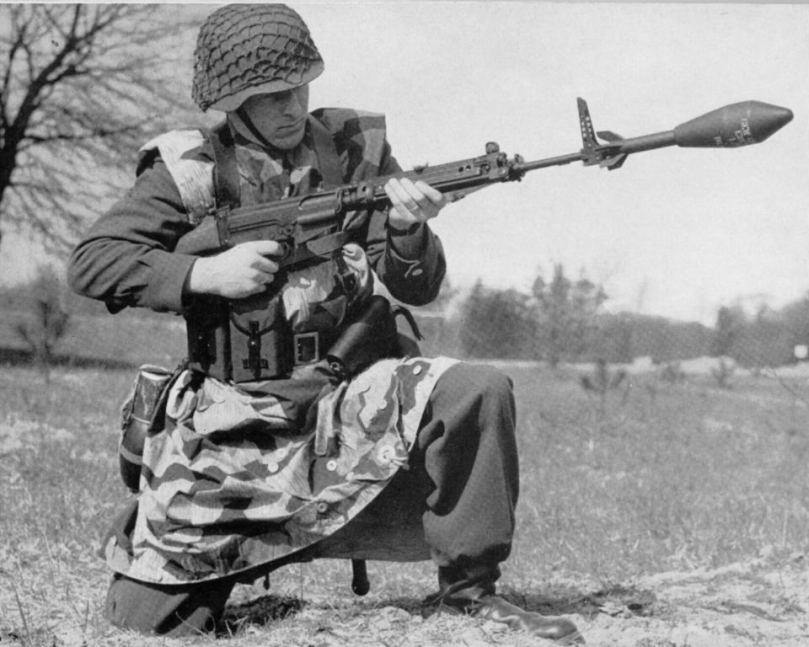
(BGS trooper in the 1960s with tarnnetz on his stahlhelm M35/53 helmet. This was after the switchover to the G1 assault rifle. The weapon being demonstrated is the Energa 75mm rifle grenade which could penetrate light armor out to about 105 yards. The BGS also used another rifle grenade, the Blitz, which was a flashbang model. The trooper is wearing the standard camo smock and carries a WWII canteen.)
The M35/53 remained the BGS’s helmet throughout the whole Cold War. Fairly surprisingly, it was rarely commented on from a political perspective. The BGS troopers themselves liked it. One benefit to using a helmet different from both the Bundeswehr and US Army was that tense East German troops looking through binoculars could (hopefully) recognize the stahlhelm as legitimate border patrolling by the BGS and not NATO troops massing on the border.
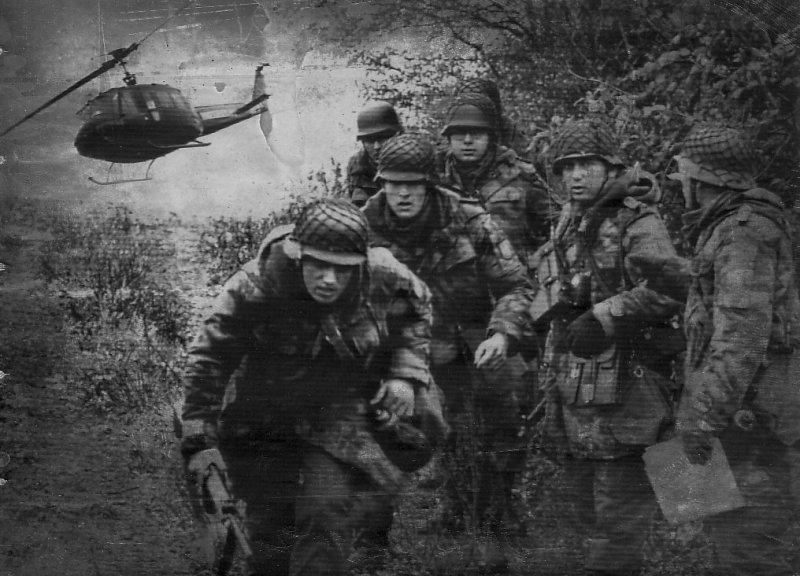
(BGS troopers in 1970 with G3 assault rifles and tarnnetz on their stahlhelm M35/53 helmets. The BGS flew thirteen UH-1 Iroquois helicopters, which were manufactured under license in West Germany by Dornier. By regulation, the BGS’s hueys were unarmed and did not wear the Luftwaffe iron cross insignia.)
Gas masks
During the Cold War it was just assumed as a certainty that a conflict between NATO and the Warsaw Pact would involve chemical and nuclear weapons. Because of their operating area on the border, BGS troopers would have certainly been exposed to fallout and poison gas during any attack on West Germany.
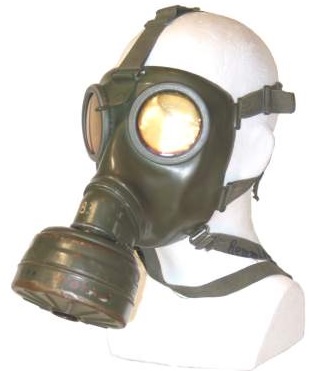
(WWII Gasmasken M38)
During the 1950s and 1960s, the BGS used ex-Wehrmacht M38 gas masks. The choice was logical as WWII veterans were trained in them, and the M38 was designed with the M35 stahlhelm in mind. The WWII gasmaskenbüchse (gas mask can) was also reused. The BGS troopers did not always carry the M38s on patrol and when not in use, they were stored out of the can to prevent deformation of the aging rubber.
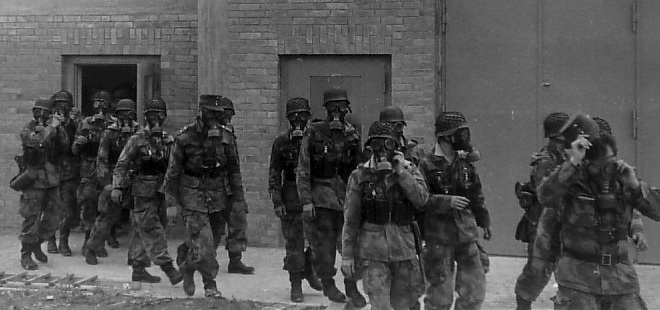
(BGS troopers in M38s after a NBC warfare training session in a gas chamber.)
Canteens
The BGS adopted the Wehrmacht’s Feldflasche 31. Like the stahlhelms, these canteens were donated by the western Allies from warehoused WWII captures. When these began to wear our, a new production run was ordered in the late 1950s. These were designated Feldflasche 31/57.
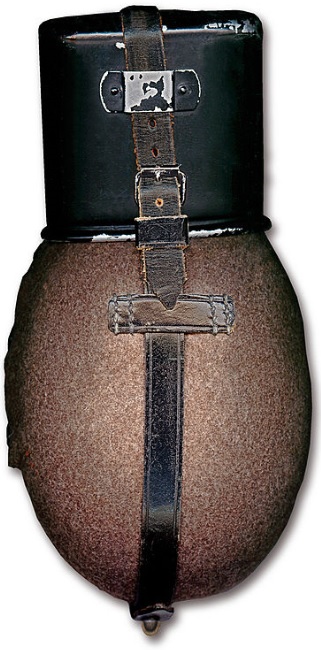
This canteen could attach to either the belt or breadbag and came with a drinking cup. The cover was a felt material intended to be wetted and cool the contents by evaporation.
Other
The BGS’s cloth hat, the Bergmutze M51, was essentially the same as the Einheitsmutze M43 cap of WWII.
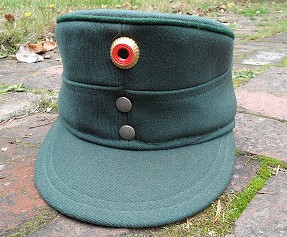
Especially early in the BGS’s history, other Wehrmacht kit items such as Y-belts, ammunition pouches, etc were used as well.
The BGS investigated a number of WWII camouflage patterns, both German and Allied, including the Waffen-SS’s liebermuster and flecktarn types. In the end, these were not adopted and an original style called sumpftarn was used, in three color patterns, the most common seen below.
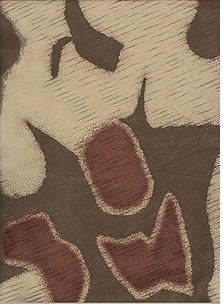
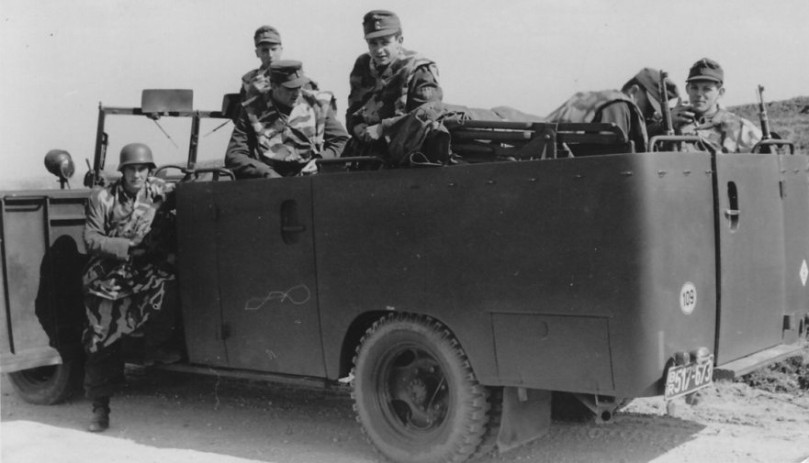
(A motorized BGS patrol in the mid-1950s showing the stumpftarn smock and Bergmutze M51 cap along with a stahlhelm M35/53. The weapons in the truck are WWII 98k rifles.)
There was originally no WWII winter camouflage cover for the stahlhelm M35/53 and the limited-budget BGS could not afford to repaint them all seasonally, so BGS troopers inserted sheets of office paper into the tarnnetz, as seen below. Later the Bundeswehr’s winter M1 pot helmet cover was used as it could be adapted to the stahlhelm with a little effort.
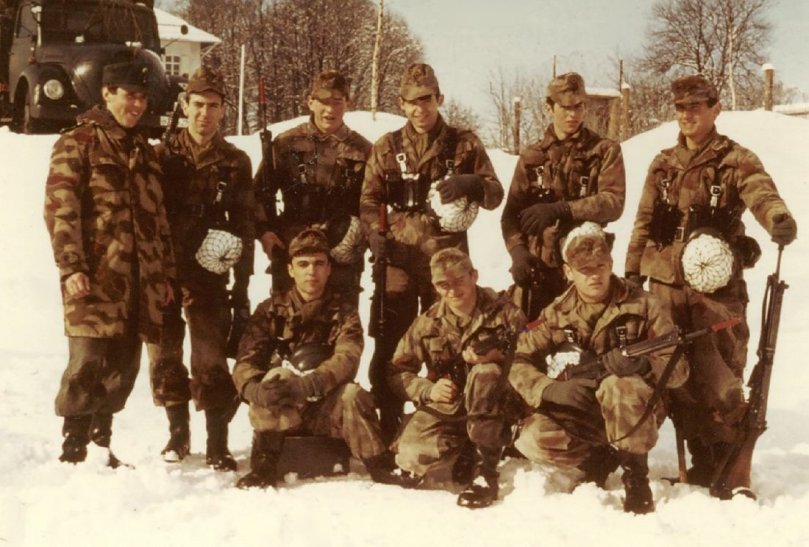
The situation of West Berlin
One area where the BGS did not operate was West Berlin. This city was directly administered by France, Britain, and the USA and was technically never a legal part of West Germany. However, civilians in West Berlin were West German citizens, but they could not be drafted into the Bundeswehr, and could not vote in national elections (although they were eligible to run as candidates for national office). West German civil law generally applied in the city, which existed in a bizarre legal grey area from the end of WWII until the end of the Cold War.
Because West Berlin was, strictly speaking, not technically part of West Germany, both the Bundeswehr and BGS were prohibited from operating there. There was however an organization called Bereitschaftspolizei Berlin (Berlin barracked police) which performed similar duties to the BGS and was equipped with similar gear.
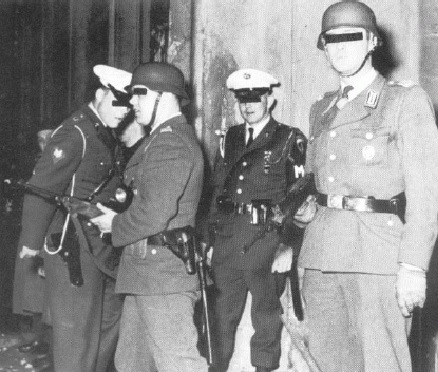
(Bereitschaftspolizei Berlin personnel with stahlhelm M35/53 helmets, a 98k and G1, and P1 sidearms. The uniform style of the American MPs dates the photo to the early 1960s.)
The civilian West Berlin police department used P1 and P3 handguns as well.
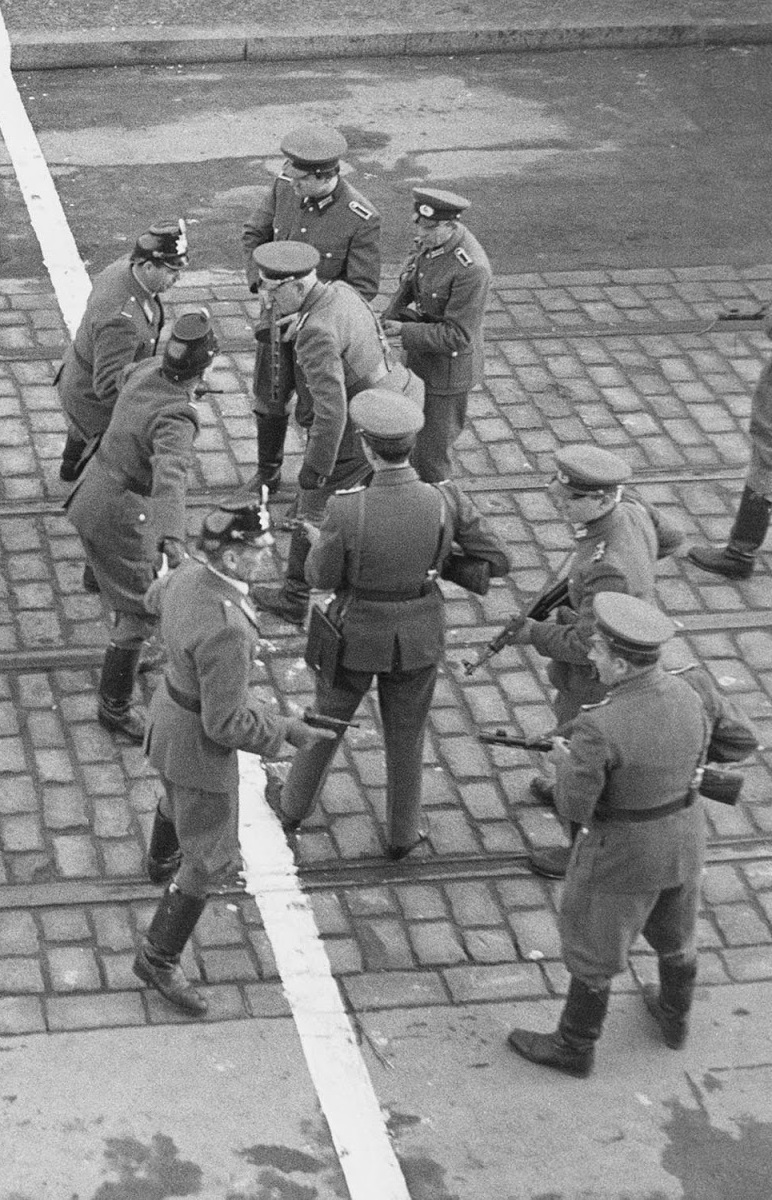
(Taken before the Berlin Wall was built, this photo shows West Berlin police department officers squaring off with East German troops. They are forming a human shield to protect an East German woman who had just run across the line. The policeman are armed with P1s. Meanwhile the East Germans are armed with Cold War-era AK-47s and WWII Soviet PPSh-41 submachine guns.)
End of WWII equipment in the BGS
In 1976 the BGS lessened it’s para-military stance and adopted a more law enforcement type look. A green uniform replaced the earlier models for barracks and street wear, but the stahlhelm remained in use. By the close of the decade, it was the only WWII-era item still in use, along with the MG-42’s offspring, the MG3.
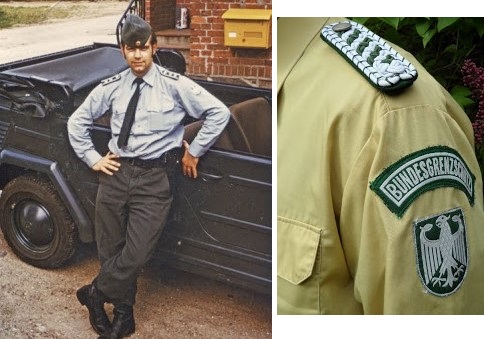
(The left photo shows the barracks uniform of the BGS from 1951-1976, with Wehrmacht-style feldgrau moleskin trousers and garrison cap, and black leather holster for a P1. The right photo is the 1976-2001 uniform which had nothing in common with WWII styles.)
The reunification of Germany in 1990 was of course a monumental event, with the country’s new eastern border now what had been East Germany’s border with Poland. Many of the 1951-era bases formerly along the former west/east border were now marooned deep in the German heartland and of no use to a border patrol force. These were closed during the 1990s.
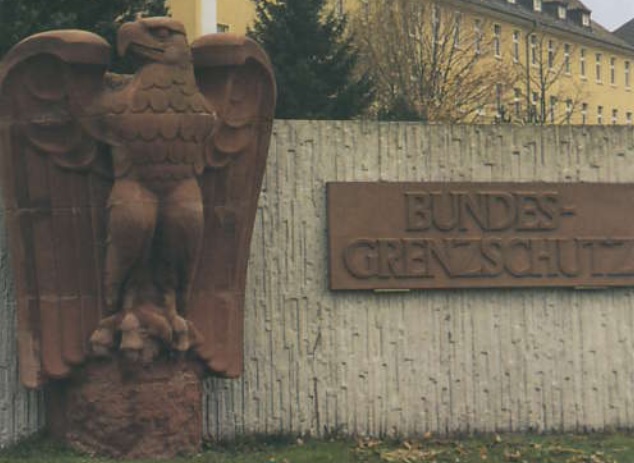
(One of the BGS’s bases was Hindenberg Kaserne at Eschwege. This had been a minor Wehrmacht base during WWII. During the occupation, it was briefly used by the US Army but then relinquished as it was considered dangerously close to the border. When the BGS took custody in 1951, they found this reichsadler (eagle holding swastika in wreath) statue left over from WWII. American GIs had defaced the swastika. A local sculptor chipped off what remained and turned the top of the wreath into somewhat oversized talons. BGS called the statue the Manikürevogel (manicured bird). The Eschwege base was left dead center in the middle of Germany after the border was erased and shut down in 1997.)
In the mid-1990s a new kevlar helmet (below) replaced the stahlhelm M35/53 and with that, the BGS’s last link to WWII ended. In July 2005, the Bundesgrenzschutz was rolled into the Bundespolizei (federal police).
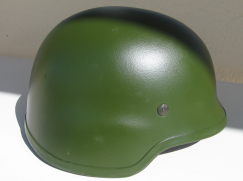

[…] Source: WWII equipment of the Bundesgrenzschutz […]
LikeLike
Impressive research!
LikeLike
What an impressive post! The Cold War is a fascinating period of time especially that tense period just after the war. Seeing opposing troops squaring off at each other would be comical if not so serious at the time. Really strange to see a mix of ww2 and Cold War weapons! Uniforms etc. but I guess that was the obvious thing to do. A Fabulous post.
LikeLiked by 1 person
Since the late 1970s, I’ve studied the Bundesgrenzschutz & even published a rather crude article in about 1980 (before much information was available in U.S.A.). Although the author disagrees slightly with some other sources, this article is impressive in its detail — outstanding work which makes me want to perform additional research.
LikeLiked by 1 person
Very interesting article indeed.
LikeLiked by 1 person
This is the best article I have ever read about the BGS in English, thank you for researching and sharing !
LikeLiked by 1 person
the foto of the BGS NCO with the breast badge denoting a unit leader is actually a BGS officer and that is a post war sports badge not a leadership badge.
LikeLike
correct! I still have mine! … good observation, John
LikeLike
I have always had an interest in international border crossings, so the information about the comparison between the West German side of the border and the East German side of the border was fascinating!
LikeLiked by 1 person
As someone, who has studied and collected BGS for a number of years and German speaker, noticed a number of errors in this article. Hopefully not mind a few corrections?
Enfield was never used by BGS, but Sicherungstruppen of the Luftwaffe/Bundeswehr (instead of M1 issued to Heer units). Photo show clearly BW soldiers… M1911 was also an early Bundeswehr pistol never used by BGS. BGS used the Astra 600 and small numbers of SIG P210-4. The P38/P1 pistols not adopted by BGS until about 1963 – after the Bundeswehr. BGS referred to Beretta as MP “Beretta”, MP1 was a BW designation at least in the earlier years (same with P3 for Astra, etc.).
Helmet has national shield found only on Hamburg and Bremen police helmets, but colour look more like West Berlin. Definitely not BGS, which were always textured and greener. First BGS helmets in 1951 were WW2 shells fitted with modified version of Riddell suspension. After 1953 come the newer “M53” leather liner with metal frame and no rivets (first with vents, then without). Postwar production helmets with rivets were never BGS contract, but state police.
BGS made their own gasmasks and cans copied from WW2 models (with very small differences). Same with canteens, these were produced as early as 1951 and most other field gear items.
btw the West Berlin police/Volkspolizei confrontation is scene from a 1962 film “Oggi a Berlino”.
LikeLike
I served with the 3d Squadron of the 2d Armored Cavalry Regiment in Amberg, West Germany, 1962-64, and was impressed by the BGS. While commanding Troop I, and at Camp Pitman in Weiden, the local BGS regiment was conducting an aerial staff ride along the West German – Czechoslovak Border and had received permission to land its
five Alouette helicopters inside the Camp to refuel them and eat lunch. Their meal was in insulated containers. Our mess hall had already served lunch and was available, so I invited them them to use it and avoid sitting on the ground to eat. My mess sergeant offered up plenty of hot coffee and ice cream to round out their meal. (cont.)
LikeLike
(continued) The BGS Regimental Commander invited me to join him and asked , after a few general comments, if I knew what the BGS was. (I knew that they regarded themselves as the keepers of the qualities of the post WWI “Hundred Thousand Man Army”, regarded as the best German Army.) So I replied, “Yes Sir, you’re like the Hundred Thousand Man Army.” He looked at me a couple of seconds and said, “Ah,
you understand.”
LikeLiked by 1 person
hello can you please tell me if the ties were black or dark blue neck ties for the BGS in the 1950s 🙂 I have seen some German army ties for sale but they are dark blue but in the photos of the BGS they look black
thanks in advance
Dennis
LikeLike
I am honestly not 100% sure if they were dark navy blue or true black, sorry!
LikeLike
Black! The uniform was green.
LikeLike
ties were dark green! There exist period colour photos from early years and have handled originals.
LikeLike
Klaus is correct the ties were dark green. I know, because I was a member of them from 1955 till 1964 until I immigrated to the USA. Who ever put this article together did a wonderful job.
LikeLiked by 2 people
Hello Juergen! Can you tell me more about your uniform during the 1950s?
LikeLike